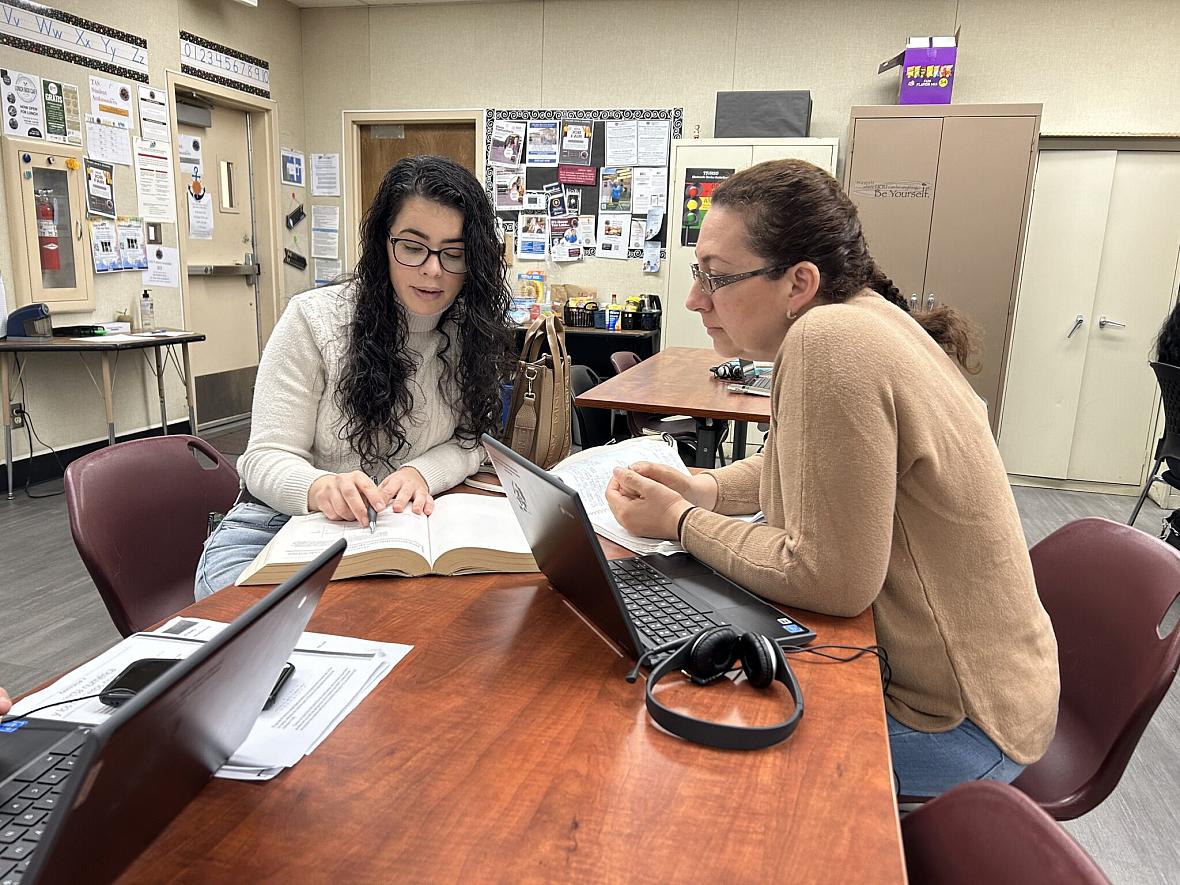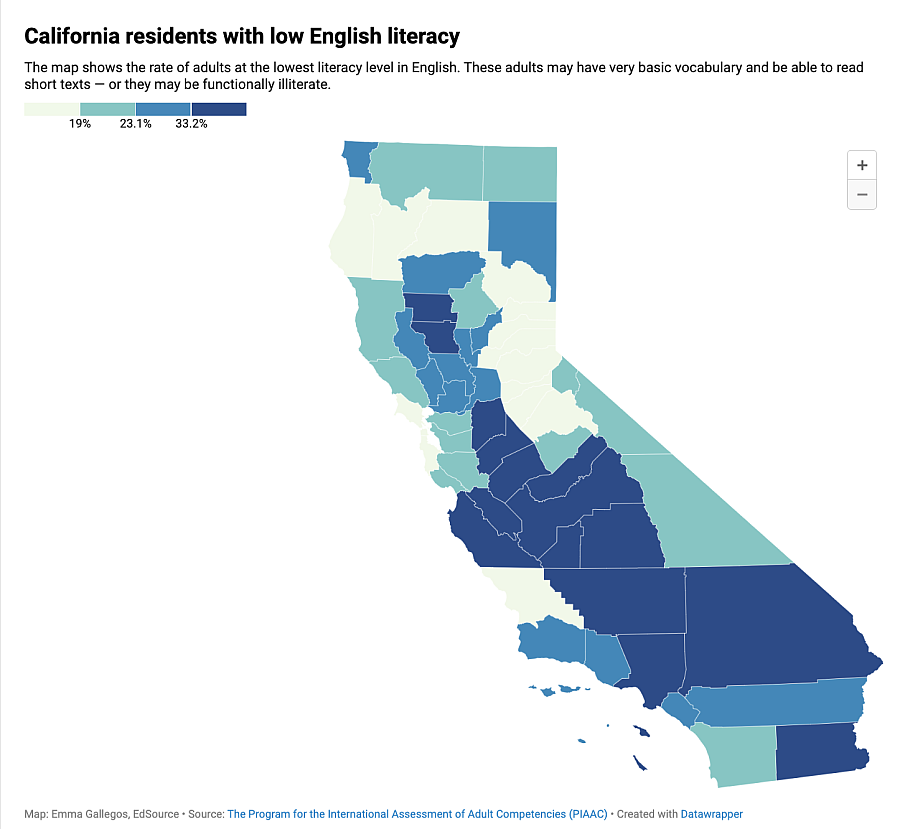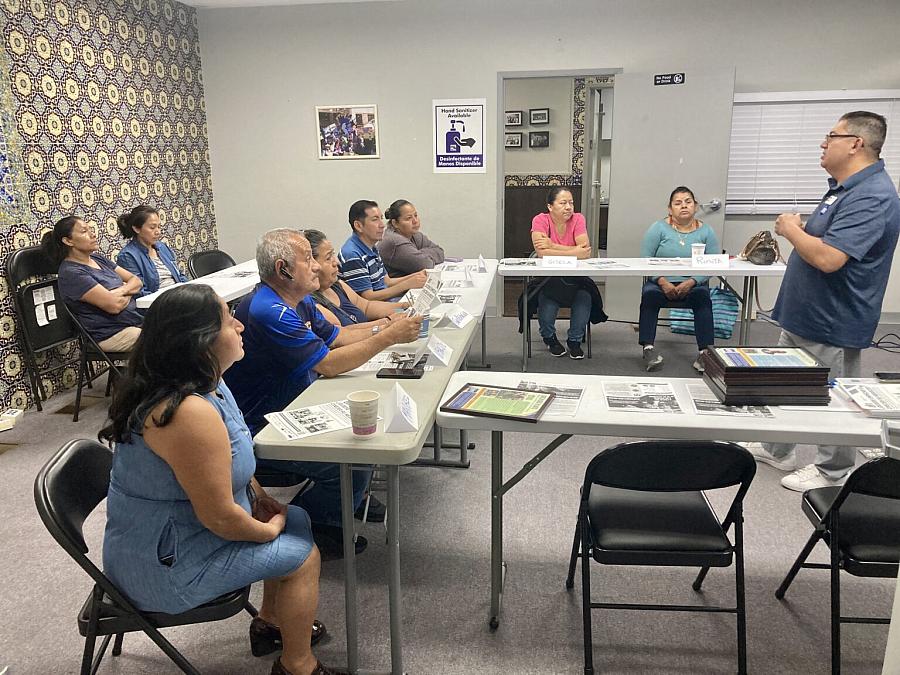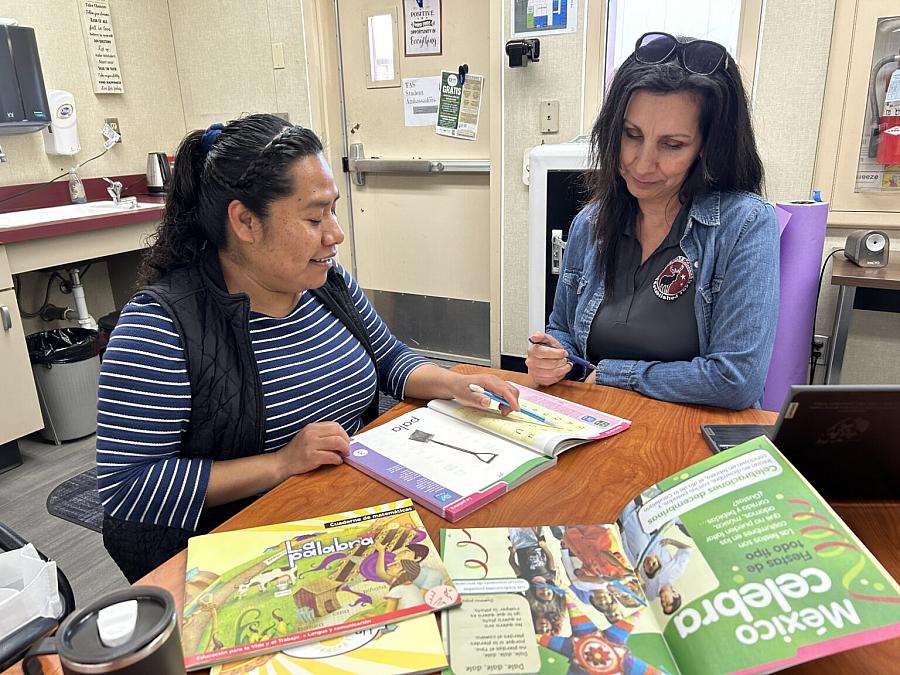When you can’t read a medicine bottle: California immigrants struggle with low English literacy
The story was originally published by EdSource with support from our 2023 Data Fellowship.

Analilia Gutierrez, left, tutors Isabel Gutierrez, right, during a Spanish GED class at Tulare Adult School.
EdSource/Emma Gallegos
Nine years ago, Analilia Gutierrez gave birth to her son, a micro preemie who needed intensive care.
At the time, Gutierrez, an immigrant from Mexico, spoke and read little English. Filling out health forms and trying to keep up with her son’s care was an overwhelming experience. Interpreters, if available, sometimes created problems with misinterpretation.
“There were so many barriers,” said Gutierrez, a resident of Tulare, in the Central San Joaquin Valley.
In California, an estimated 28% of adults have such poor literacy in English that they struggle to do anything more complicated than filling out a basic form or reading a short text, according to a survey, the Program for the International Assessment of Adult Competencies (PIAAC). California’s rate is worse than any other state except New Mexico, where the estimated rate is 29%.

The U.S. version of the survey was conducted only in English, and many immigrants, unsurprisingly, tend to struggle more with what is often not their home language: 19% of adults in California say they speak English “less than very well,” according to 2022 American Community Survey data.
Not being able to read English well doesn’t just make life difficult — it can be dangerous.
As the CEO of the Central San Joaquin Valley-based Clinica Sierra Vista, Dr. Olga Meave routinely sees patients who struggle to read in any language. Sometimes it’s a patient who doesn’t know how to sign their name. Other times, patients can’t read the directions. One patient ended up in the emergency room after taking the wrong dose of blood thinners, which caused their stomach to bleed.
Low literacy is particularly acute in heavily agricultural regions, such as the Central San Joaquin Valley and the Central Coast, that rely on a largely immigrant labor force that may have little formal education, even in their home languages. More than 4 out of 10 residents in Imperial, Tulare, Merced, Madera, Kings and Monterey counties struggle with basic English literacy.

But signs of adults who struggle to read are in every community in California: job seekers unable to get jobs or promotions; business owners who cannot complete paperwork for loans and grants; prisons with a disproportionate number of struggling readers and parents who cannot help their children with homework or even read bedtime stories.
No state has more immigrants than California: Over a third of adults over 25 are immigrants, according to 2022 American Community Survey data. Most are from Mexico and other Latin American countries, but an increasing number hail from Asian countries. Nearly half of children in the state have at least one parent who is an immigrant.
Immigrants make up a huge share of workers in key industries in California. While highly educated immigrants bring their in-demand skills to the tech industry, those who work in agriculture may have little or no formal education.
Experts say programs aimed at addressing poor literacy reach only a fraction of those who need help, such as courses that improve English skills, help students get a GED or their citizenship or even a basic education. In California, that is largely adult immigrants. In 2021-22, adult schools served over 480,000 students in California, while the state says more than 10,000 adults were served through library tutoring programs in 2022-23.
Those numbers are dwarfed by the need for adult education from immigrants alone: 5.9 million Californians don’t speak English “very well” and 2.9 million immigrants lack a high school education, according to 2022 American Community Survey data.
Programs that serve adult students are often plagued by long wait lists, a lack of funding or a lack of accessibility. Advocates say that one of the biggest problems is simply that adult education seems to fly under the radar in a way that TK-12 schools and colleges don’t.
“We are the best-kept secret in education,” said Carolyn Zachry, education administrator and state director of the Adult Education Office for the California Department of Education.
As a new immigrant, Gutierrez didn’t have time to take classes while she was focused on raising young children. Now that her children are school-aged, she has been able to attend Tulare Adult School, and her world has opened up.
Gutierrez has since become an American citizen and she has earned a GED. Her newfound English skills recently helped her land a job at Chipotle. She is now able to help her son and daughter with their homework and read to them in the evenings, a ritual she treasures. She thinks about how much easier it would have been to navigate the hospital during her son’s traumatic birth with the education she has now.
“I would now have the knowledge,” Gutierrez said. “It’s so much different.”
‘Their circles are small’
Research has found that an adult’s literacy skills are strongly connected to their income and civic engagement, as well as their health. The effects of low literacy are felt not just by individuals and their families but by local and national economies. That’s why researchers say adult education is a worthy investment.
A 2020 Gallup study, conducted by economist Jonathan Rothwell, estimated that if everyone in the U.S. was minimally proficient in English literacy, according to the standards of the international PIAAC survey, it would increase the gross domestic product by 10%. This study looked at the literacy levels of both immigrants and native residents.
The Gallup study noted that areas with concentrated low literacy would see the biggest financial gains from this kind of improvement. One of those places is the Merced Metro Area, in the Central Valley. It would stand to gain an estimated 26% of its GDP, largely because 72% of its adults are not proficient readers, the report said.
The study estimated that those at the lowest level of literacy made on average $34,127 in 2020 dollars, while those who scored proficient made on average $62,997.
Immigrants tend to earn less than natives, but a Migration Policy Institute analysis of PIAAC survey data found that immigrants and native workers with similar literacy and math skills tend to earn the same amount. This report says that immigrants “need higher levels of English competency to be paid well — and on par with natives — for their work in the U.S. labor market.”
Struggling to read as an adult can be a shameful, lonely experience for those who grew up speaking English. But for immigrants, the experience of not being able to read well can be even more isolating when they cannot speak English or are not a citizen. Christine Spencer, a Tulare Adult School instructor, wishes that many more immigrants in her community were taking advantage of these classes.
“My students tell me that they have no friends,” said Spencer. “Their circles are small.”
Bringing literacy into workplaces is a ‘secret sauce’
When Marcelina Chamu emigrated from Mexico decades ago, she longed to do more than just get by. She hoped to become a citizen, learn English, all while creating a better life for her family in the U.S.
But getting the education to achieve those goals wasn’t easy. Chamu, 58, is part of a vast, largely immigrant, labor force of custodians who begin their work shifts in office buildings just as the sun is going down. For the last 25 years, she has clocked in at 6 every night. Because of her work schedule and raising four children, she put off her own education for decades.
“It is very difficult for someone who works through dawn to get up and start studying,” Chamu said, in Spanish. “But it’s not impossible.”
Advocates say that the best way to target immigrants is by reaching them wherever they are in the community — whether that’s at their child’s school or workplace.
Immigrants with low English literacy skills tend to have jobs — more so than U.S. natives with low literacy and more so than immigrants in other nations, according to the Migration Policy Institute. That means they’re busy, but it also means they are easy to reach at work.
One program in California is doing just that, and it helped Chamu.
A few years ago, Chamu learned that her union, SEIU-United Service Workers West, had a partnership with a nonprofit called the Building Skills Partnership, which aims to improve the lives of property service workers in low-wage jobs along with their families.
Chamu has done her best to take advantage of all the programs she could: citizenship, English courses, free tax preparation and nutrition courses. She has become more confident going to the grocery store and filling out forms in the doctor’s office.
The California-based Building Skills Partnership estimates that it reaches 5,500 workers and community members each year through in-person courses, and another 20,000 through online classes throughout the state.
“Part of the secret sauce of why we’re so effective is that we’re able to take our programming into where workers are at,” said Building Skills Partnership executive director Luis Sandoval.

An instructor with Building Skills Partnership teaches a class of custodians in Orange County.
Courtesy of Building Skills Partnership
Property workers, who tend to be clustered around large metro areas in the Bay Area and Southern California, can take part in programming before they head into work or during their lunch hour, which might be at 10 p.m.
Reaching immigrants at their workplaces isn’t just convenient, it allows these programs to cater to workers’ language and job needs, said Jeanne Batalova, senior policy analyst at the Migration Policy Institute.
She points to the Welcome Back Initiative, which focuses on tapping the talents of internationally trained health care workers who need help with specialized English skills or acclimating to a different type of health system to fill staffing shortages in California’s health care sector.
But work-based programs are rare in the U.S., where employers often view workers in low-skilled positions as easily replaceable. The Migration Policy Institute report says these work-based programs could be expanded through subsidies or other incentives, which exist in Canada and other European countries.

Tulare Adult School instructor Yolanda Sanchez, right, assists her student Mariana Gonzalez.
EdSource/Emma Gallegos
Building Skills Partnership offers English paired with vocational training. Many workers in the program take English classes with an eye on switching to a more desirable daytime shift. Custodians who work during the daytime are expected to interact more with office workers, so their English skills matter more.
Rosa Lopez, 55, a custodian in a downtown San Diego building, is taking vocational English classes. That allows her to more easily communicate with security guards, a supervisor who only speaks English or just to direct a guest to the elevator.
Lopez said, “I’m more confident and secure in my position.”
Adult schools run on ‘dust’
Sometimes Beatrice Sanchez, 35, a stay-at-home mother of six, comes home from the store with the wrong items because she can’t read the labels in English. She is eager to take the English courses offered at her local school district, Madera Unified, but the program doesn’t currently offer child care. She said she will have to wait to take the courses until her youngest two children are in kindergarten.
Many of those most in need of adult education, like Sanchez, don’t have the time or resources to attend. Adults find it hard to squeeze in time between raising children and working. Even if they have time, transportation can be tricky — particularly in rural areas that lack an extensive public transportation system.
Some Americans used to view poor literacy as an individual’s failure to study during childhood, said Sarah Cacicio, the director of the Adult Literacy and Learning Impact Network (ALL IN), a national nonprofit focused on adult literacy. Now, she said, there is an increasing understanding that systemic factors — never-addressed learning disabilities, a chaotic home life, obligations to care for family or simply a poor education system here or abroad — may mean reaching adulthood without knowing how to read English well.
Most states rely entirely on skeletal funding from the federal government. In 2021-22, the federal government spent less than $800 per student on adult education classes aimed at English language, civics skills, and basic or high-school level education.
California provides robust additional funding. During the 2021–22 years, the state spent roughly $1,200 on each student who enrolled in adult education classes — primarily adult schools or community colleges. But adult educators say it’s not enough to meet the great needs of its students.
Adult schools, said John Werner, president-elect of the California Council for Adult Education “do it on dust. I don’t know how we pull it off.”
In California, adult education receives a fraction of the funding per pupil that TK-12 schools do. Werner said that more funding would allow programs serving adults to get rid of wait lists, improve their technology and facilities, and increase access by offering the child care so many of its potential students need.
Adult educators see the work of their field as an investment not just in individual adult students but in their families and greater communities.
“If we can pull (adult students) in,” Zachry said, “we can raise the economics of that family.”
Werner, director of the Sequoia Adult Education Consortium, said he’s proud of the work being done by the consortium that serves Tulare and Kings counties, which he calls the “Appalachia of the West.” But he is frustrated to see that adult schools are reaching just an estimated 8% of the adults in the region who need it.
“If we could just invest in this,” Werner said. “The greatness that would come out of this.”
SIDEBAR: GOING DEEPER
Unlike the data measuring students in TK-12 schools or college, surveys of adult skills in reading and math occur only sporadically in the U.S.
The most recent data comes from the Program for the International Assessment of Adult Competencies (PIAAC), an international survey of adults’ basic skills of literacy, as well as numeracy and digital problem-solving. In the U.S., the survey was offered only in English, although background questions were offered in Spanish.
Between 2012 and 2017, the National Center for Education Statistics administered the first cycle of the PIAAC survey to 12,330 U.S adults ages 16 to 74 in all 50 states.
The second cycle of PIAAC surveys was conducted in 2022-23, and results are expected later this year.
Level 1 is the lowest literacy level in the PIAAC survey. Adults at this level struggle to understand written material or may be functionally illiterate. Level 2 means that an adult is approaching proficiency in literacy, while Level 3 signals the minimal proficiency an adult needs to function well. It means being able to understand and interpret information across complex written texts. Levels 4 and 5 represent advanced literacy skills.

